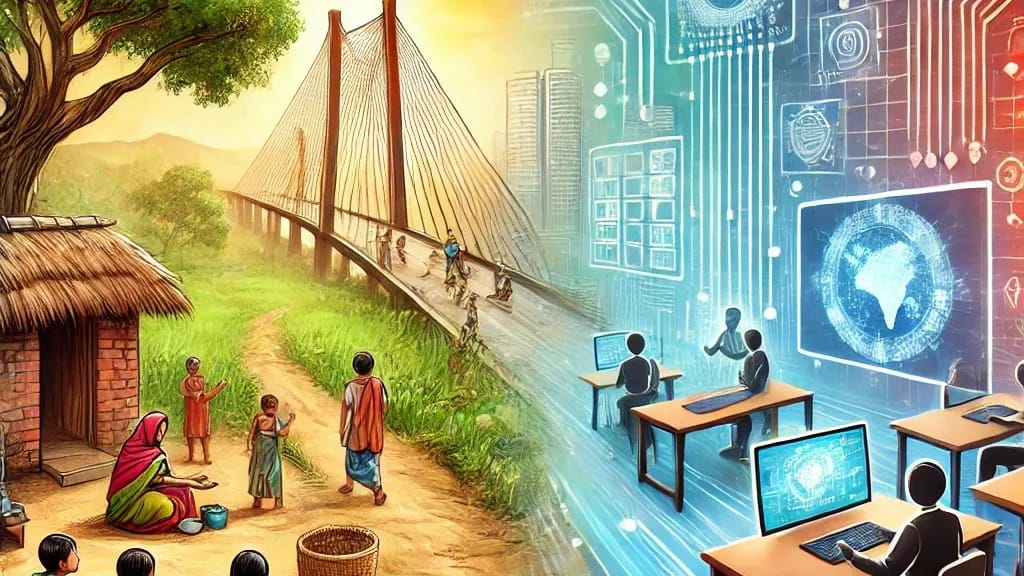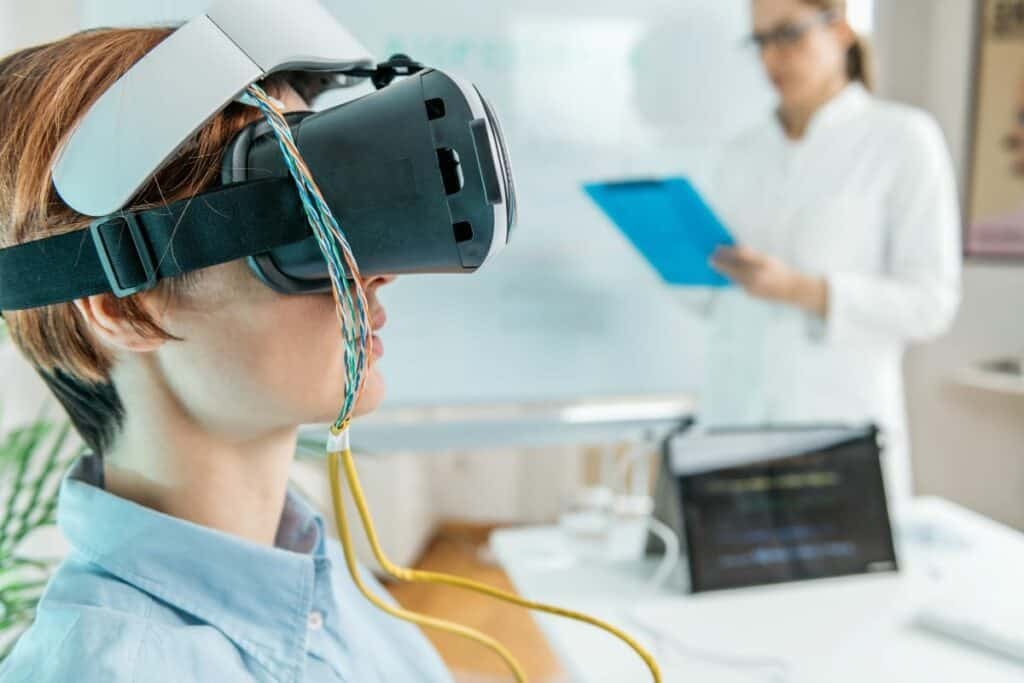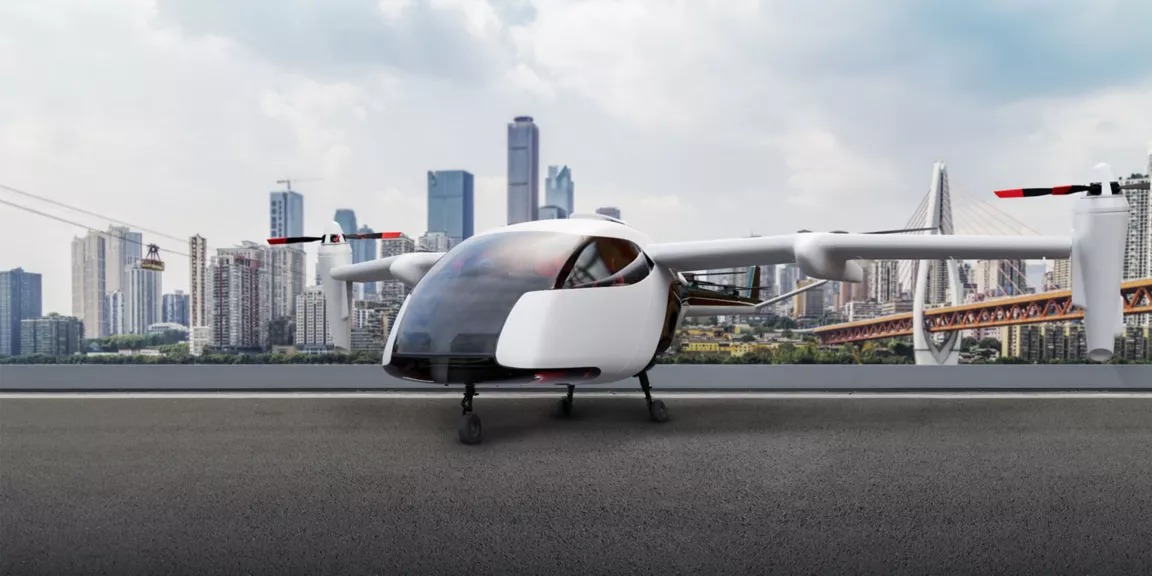
Smart Solutions for a Smarter Nation: Technology’s Role in Rural and Urban Development
Technology is revolutionizing both rural and urban development by improving education, healthcare, agriculture, transportation, and governance. Smart solutions like IoT, AI, digital banking, telemedicine, renewable energy, and e-governance are bridging gaps, enhancing efficiency, and promoting sustainable growth.
✨ Raghav Jain

Introduction
Technology is no longer just a luxury—it’s the backbone of modern development. From bustling cities to remote villages, smart solutions are transforming the way we live, work, and interact. Urban areas benefit from high-speed connectivity, automated systems, and advanced infrastructure, while rural regions gain access to education, healthcare, and economic opportunities previously out of reach.
A “smarter nation” is one where technology bridges the gap between rural and urban spaces, enhances efficiency, promotes sustainability, and empowers citizens. In this article, we’ll explore the role of technology in rural and urban development, how it improves lives, and practical ways individuals and communities can leverage these solutions daily. In the twenty-first century, technology has emerged as the driving force behind the transformation of societies, economies, and governance systems. It has redefined the way people live, work, and interact, serving as a catalyst for growth and development across both rural and urban areas. For nations aspiring to achieve inclusive progress, leveraging technology is not merely an option; it is a necessity. By integrating innovative solutions into daily life, governments, organizations, and communities can bridge socio-economic gaps, enhance quality of life, and create a smarter, more connected nation.
One of the most profound impacts of technology is observed in the domain of urban development. Cities, often the engines of economic growth, face a multitude of challenges, including traffic congestion, pollution, inadequate infrastructure, and inefficient resource management. Smart city initiatives, powered by technology, provide an integrated approach to tackle these challenges. For instance, the use of Internet of Things (IoT) sensors allows real-time monitoring of traffic patterns, water supply, and waste management. Smart traffic management systems reduce congestion by optimizing traffic lights and providing commuters with real-time updates, ultimately saving time, fuel, and reducing carbon emissions. Similarly, IoT-enabled waste management ensures that garbage is collected efficiently, preventing unsanitary conditions and promoting environmental sustainability. Through these solutions, technology transforms cities into hubs of efficiency, sustainability, and improved quality of life.
Beyond infrastructure, technology plays a crucial role in enhancing public services and governance in urban areas. Digital platforms streamline access to government services, making it easier for citizens to obtain essential documents, pay bills, or report civic issues. Mobile applications and online portals eliminate bureaucratic hurdles, fostering transparency and accountability. Additionally, technology-driven solutions in healthcare, such as telemedicine and electronic health records, make medical services more accessible and efficient. Urban residents can consult doctors remotely, receive timely diagnoses, and monitor their health conditions through wearable devices. Education also benefits from technology, as smart classrooms, online learning platforms, and virtual labs provide students with enhanced learning experiences and equitable access to knowledge.
While urban areas are rapidly embracing technological solutions, rural regions often face distinct challenges. Limited infrastructure, geographical isolation, and restricted access to resources have traditionally hindered rural development. However, technology has begun to bridge this divide, creating opportunities for growth and empowerment in rural communities. Internet connectivity, mobile technology, and digital platforms have revolutionized agriculture, education, healthcare, and financial inclusion in these areas. For farmers, precision agriculture powered by IoT sensors, drones, and satellite imagery helps monitor soil conditions, predict weather patterns, and optimize irrigation and fertilizer usage. These advancements increase crop yield, reduce costs, and promote sustainable farming practices, contributing to food security and rural prosperity.
Healthcare in rural regions has also experienced a transformative shift due to technology. Telemedicine services connect remote populations with skilled healthcare professionals, overcoming barriers of distance and scarcity of medical facilities. Mobile health units equipped with diagnostic tools and digital health platforms ensure timely treatment, disease monitoring, and health awareness campaigns. By integrating technology into rural healthcare, nations can reduce mortality rates, prevent epidemics, and enhance overall public health. Similarly, education in rural areas has gained momentum through digital classrooms, online courses, and e-learning initiatives. Children and adults alike can access quality education without being limited by geographic constraints, fostering skill development, employment opportunities, and social mobility.
Financial inclusion is another crucial area where technology plays a pivotal role. Digital banking, mobile wallets, and online payment systems provide rural populations with secure, convenient access to financial services. Farmers, small business owners, and self-help groups can participate in the formal economy, access credit, and conduct transactions efficiently. Government welfare schemes delivered through digital platforms ensure that benefits reach intended beneficiaries transparently, reducing corruption and administrative delays. By empowering individuals with financial tools, technology enables rural communities to participate in economic growth and improve their standard of living.
The integration of technology in both rural and urban development contributes not only to economic progress but also to environmental sustainability. Smart grids, renewable energy systems, and energy-efficient infrastructure minimize resource wastage and reduce carbon footprints. IoT-enabled monitoring of air and water quality helps governments and communities respond proactively to environmental challenges. By promoting sustainable practices and responsible resource management, technology ensures that development does not come at the cost of ecological degradation.
Moreover, technology fosters social connectivity and empowerment. Digital platforms enable citizens to voice concerns, collaborate on community initiatives, and participate in decision-making processes. Social media, online forums, and mobile applications facilitate awareness campaigns, knowledge sharing, and collective problem-solving. By bridging the gap between policymakers and communities, technology strengthens civic engagement and promotes inclusive governance.
Despite its immense potential, the implementation of technology-driven solutions faces challenges such as digital literacy, infrastructure limitations, and data security concerns. Bridging the digital divide requires concerted efforts from governments, private organizations, and civil society. Investment in training programs, internet connectivity, and affordable technological tools is essential to ensure that no community is left behind. Policies that prioritize data privacy, cybersecurity, and ethical use of technology are equally critical to foster trust and sustainability.
In conclusion, technology is the cornerstone of a smarter nation, capable of driving comprehensive development across rural and urban landscapes. By addressing infrastructure, healthcare, education, financial inclusion, environmental sustainability, and civic engagement, technology transforms societies into more efficient, inclusive, and empowered entities. The vision of a smart nation is no longer a distant dream but a tangible reality, achievable through strategic planning, innovative solutions, and collaborative efforts. As nations embrace technology, they lay the foundation for a future where prosperity, equity, and sustainability coexist harmoniously, ensuring that progress reaches every citizen, regardless of their location. A smarter nation, powered by technology, is not merely about urban modernization or rural upliftment—it is about creating an interconnected society where opportunity, efficiency, and well-being are accessible to all.
Understanding Smart Development
Smart development involves the integration of digital technologies into infrastructure, governance, business, and daily life. It focuses on:
- Enhancing quality of life
- Optimizing resource usage
- Encouraging economic growth
- Promoting social equity
Rural Development focuses on providing access to essential services, digital literacy, telemedicine, and e-governance.
Urban Development emphasizes traffic management, smart grids, sustainable housing, pollution control, and efficient public services.
When rural and urban areas adopt smart solutions, the entire nation benefits through connectivity, innovation, and inclusivity.
Technology in Urban Development
Urban areas are fast-paced, with high population density, traffic, and environmental pressures. Technology solutions are crucial for sustainable urban living.
1. Smart Transportation Systems
- Real-time traffic management reduces congestion and fuel wastage.
- Mobile apps provide public transport updates, ride-sharing, and e-ticketing.
- Smart parking solutions guide drivers to available spaces, saving time and reducing pollution.
2. Energy-Efficient Infrastructure
- Smart grids monitor energy consumption and prevent power wastage.
- Solar-powered streetlights and smart meters reduce carbon footprints.
3. Waste Management
- IoT-enabled bins signal when full, streamlining waste collection.
- Recycling apps and AI sorting solutions increase efficiency.
4. Healthcare Access
- Telemedicine apps and health monitoring wearables provide timely interventions.
- Hospitals use digital records and AI diagnostics to improve patient care.
5. Safety and Surveillance
- CCTV cameras integrated with AI detect crimes or traffic violations.
- Smart street lighting improves public safety at night.
Technology in Rural Development
Rural communities often face challenges like limited healthcare, poor education infrastructure, and lack of connectivity. Smart solutions help overcome these barriers.
1. Digital Education
- Online learning platforms bring quality education to remote villages.
- Virtual classrooms, e-libraries, and video lectures help students access resources.
2. Telemedicine & Mobile Health Clinics
- Remote consultations reduce travel time and improve access to healthcare.
- Mobile health apps track vaccinations, maternal health, and chronic disease management.
3. Agriculture & Farming Technology
- Sensors, drones, and satellite imagery help monitor crop health and soil quality.
- Mobile apps provide weather forecasts, market prices, and farming techniques.
- Automated irrigation systems save water and increase crop yield.
4. Financial Inclusion
- Digital banking, mobile wallets, and UPI ensure secure financial transactions.
- Rural entrepreneurs can access loans, subsidies, and microfinance programs online.
5. E-Governance
- Citizens can avail government services like certificates, pensions, and subsidies online.
- Reduced paperwork and faster processing enhance efficiency.
Smart Solutions that Connect Rural and Urban Areas
- High-Speed Internet & 5G Connectivity
- Enables remote work, tele-education, e-commerce, and telemedicine in villages.
- Urban and rural economies integrate seamlessly through digital platforms.
- E-Commerce & Local Markets
- Farmers and artisans sell products directly to urban customers online.
- Reduces middlemen and increases income for rural producers.
- Smart Mobility
- Bus, train, and ride-sharing apps improve accessibility between rural and urban centers.
- Renewable Energy Solutions
- Solar microgrids and hybrid energy systems power off-grid rural areas while reducing urban energy stress.
Benefits of Smart Technology for a Smarter Nation
- Economic Growth: Increased productivity, job creation, and entrepreneurial opportunities.
- Improved Quality of Life: Easier access to healthcare, education, and essential services.
- Environmental Sustainability: Energy-efficient systems, smart water management, and reduced emissions.
- Social Equity: Bridging rural-urban divides and empowering marginalized communities.
- Enhanced Governance: Faster, transparent, and accountable public service delivery.
Daily Practices to Support Smart Development
For Individuals:
- Use digital payment platforms to reduce cash dependency.
- Support local artisans and farmers through online marketplaces.
- Adopt energy-saving habits like smart meters or solar solutions.
- Participate in e-learning or online workshops for skill enhancement.
For Communities:
- Organize digital literacy programs in villages.
- Promote app-based healthcare checkups and vaccination drives.
- Use IoT and mobile apps for local waste management and water conservation.
- Encourage smart commuting options like carpooling or shared bicycles.
Weekly Practices for Smart Nation Participation
- Explore online platforms to access government schemes.
- Conduct workshops on sustainable farming practices using technology.
- Track personal energy and water usage and reduce wastage.
- Participate in community e-health camps or telemedicine programs.
- Share knowledge about digital safety, cybersecurity, and responsible internet use.
Challenges and Solutions
Challenge 1: Digital Divide
- Lack of access to internet or devices in remote areas.
- Solution: Government initiatives like BharatNet, affordable smartphones, and community centers bridge the gap.
Challenge 2: Cybersecurity Concerns
- Increased online transactions and data sharing pose risks.
- Solution: Educate citizens on strong passwords, safe apps, and phishing prevention.
Challenge 3: Resistance to Change
- Traditional practices may slow technology adoption.
- Solution: Awareness campaigns, training sessions, and success stories motivate adoption.
Challenge 4: Infrastructure Limitations
- Power outages or network issues in rural areas.
- Solution: Solar power solutions, microgrids, and offline-first apps ensure continuity.
Common Myths About Technology in Development: Busted!
“Technology is only for cities.”
→ False! Smart solutions are equally transformative for rural areas.
“Automation will take away jobs.”
→ Wrong! Technology creates new jobs, skills, and entrepreneurial opportunities.
“Only the government can implement smart solutions.”
→ Not true. Individuals, NGOs, and communities also play a vital role.
“Digital tools are complicated for older generations.”
→ With proper training and user-friendly apps, anyone can adapt and benefit.
“Rural development needs physical infrastructure, not tech.”
→ Technology complements infrastructure, making healthcare, education, and services more efficient.
Sample Daily Tech-Enabled Practices for Citizens
- Check and pay bills digitally to reduce queues.
- Use mobile apps for health tracking and reminders.
- Participate in e-learning or skill-building courses online.
- Use public transport apps or shared mobility platforms.
- Support digital campaigns for local sustainability projects.
Weekly Practices
- Volunteer in digital literacy drives.
- Attend webinars or workshops on smart farming, energy, or e-governance.
- Evaluate personal energy and water consumption using smart devices.
- Encourage neighbors and community members to adopt safe digital practices.
Conclusion
A smarter nation is not just about cities with skyscrapers and smart grids—it’s about connecting every citizen, rural or urban, to the power of technology. Smart solutions enhance education, healthcare, agriculture, energy efficiency, and governance, creating opportunities for all.
By embracing technology thoughtfully, communities reduce inequalities, foster innovation, and create a sustainable future. Every digital payment, telemedicine consultation, online learning session, or smart commute contributes to a nation that is not only modern but also inclusive, resilient, and smarter.
Start small. Embrace daily tech-enabled habits. Support your community digitally.
With collective effort, a smarter nation is not just a vision—it becomes reality.
Q&A Section
Q1:- How is technology bridging the urban-rural divide in education?
Ans :- Digital classrooms, e-learning platforms, and mobile apps provide quality education in remote areas, ensuring students have access to the same resources as urban counterparts.
Q2:- What role does IoT play in improving agriculture and farming practices?
Ans :- IoT sensors monitor soil, water, and crop health, enabling precision farming, higher yields, and reduced wastage of resources.
Q3:- How are smart cities transforming urban infrastructure and governance?
Ans :- Smart cities use data analytics, connected sensors, and AI to manage traffic, utilities, waste, and public services efficiently, enhancing quality of life.
Q4:- In what ways is telemedicine benefiting rural healthcare?
Ans :- Telemedicine enables remote consultations, diagnosis, and monitoring, reducing travel for patients and providing timely medical care in underserved regions.
Q5:- How can renewable energy solutions support sustainable rural and urban development?
Ans :- Solar microgrids, wind power, and energy storage systems provide clean, reliable energy, reducing dependency on traditional power and promoting eco-friendly growth.
Q6:- What impact does digital banking and fintech have on financial inclusion?
Ans :- Mobile banking, UPI, and digital wallets allow rural populations to access loans, savings, and financial services, fostering economic empowerment.
Q7:- How is AI improving urban mobility and public transportation?
Ans :- AI-driven traffic management, predictive maintenance, and smart transit systems optimize routes, reduce congestion, and enhance commuter experience.
Q8:- How do smart water and waste management systems benefit communities?
Ans :- Technology-enabled monitoring and automation improve water distribution, wastewater treatment, and waste recycling, ensuring healthier and cleaner environments.
Q9:- What role do government apps and e-governance platforms play in development?
Ans :- They provide easy access to public services, welfare schemes, and civic engagement tools, reducing bureaucratic delays and increasing transparency.
Q10:- How can mobile and internet connectivity empower rural entrepreneurship?
Ans :- Internet access enables small businesses to reach wider markets, access training, use digital payment systems, and adopt e-commerce solutions.
Similar Articles
Find more relatable content in similar Articles

Virtual Reality Therapy: Heali..
Virtual Reality Therapy (VRT) .. Read More

3D-Printed Organs: Are We Clos..
3D-printed organs are at the f.. Read More

E-Waste Crisis: The Race to Bu..
The rapid growth of electronic.. Read More

The Future of Electric Planes ..
The aviation industry is under.. Read More
Explore Other Categories
Explore many different categories of articles ranging from Gadgets to Security
Smart Devices, Gear & Innovations
Discover in-depth reviews, hands-on experiences, and expert insights on the newest gadgets—from smartphones to smartwatches, headphones, wearables, and everything in between. Stay ahead with the latest in tech gear
Apps That Power Your World
Explore essential mobile and desktop applications across all platforms. From productivity boosters to creative tools, we cover updates, recommendations, and how-tos to make your digital life easier and more efficient.
Tomorrow's Technology, Today's Insights
Dive into the world of emerging technologies, AI breakthroughs, space tech, robotics, and innovations shaping the future. Stay informed on what's next in the evolution of science and technology.
Protecting You in a Digital Age
Learn how to secure your data, protect your privacy, and understand the latest in online threats. We break down complex cybersecurity topics into practical advice for everyday users and professionals alike.
© 2025 Copyrights by rTechnology. All Rights Reserved.